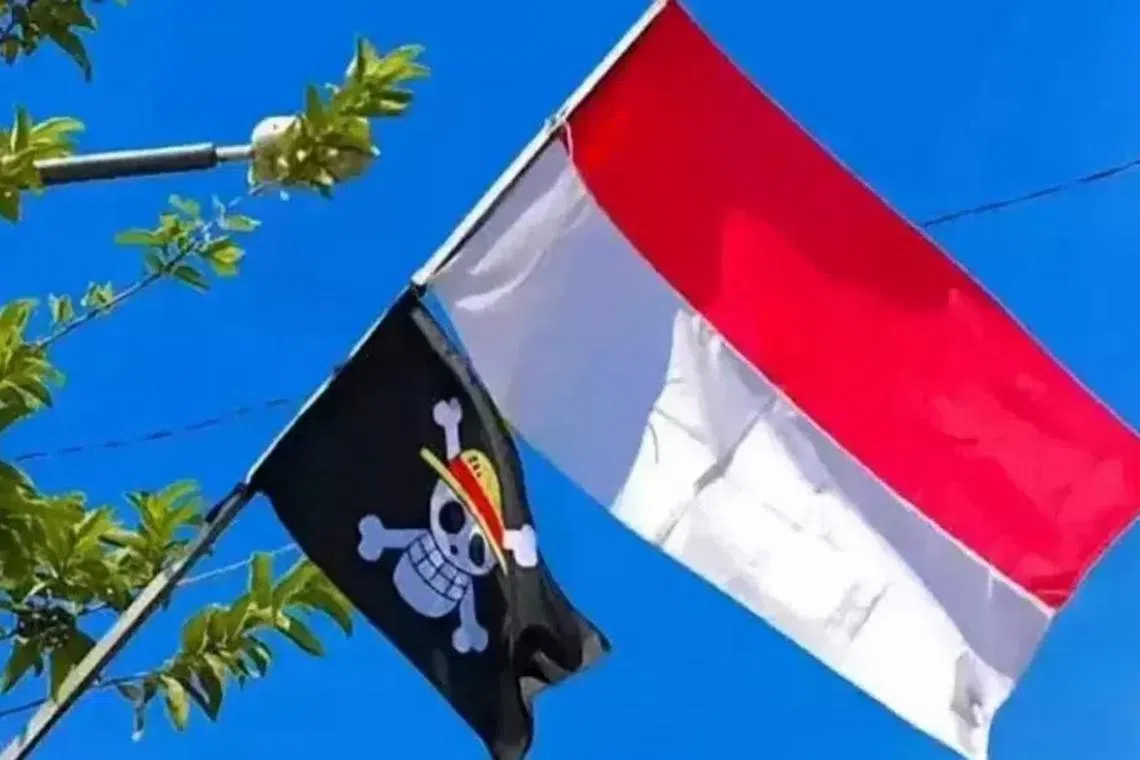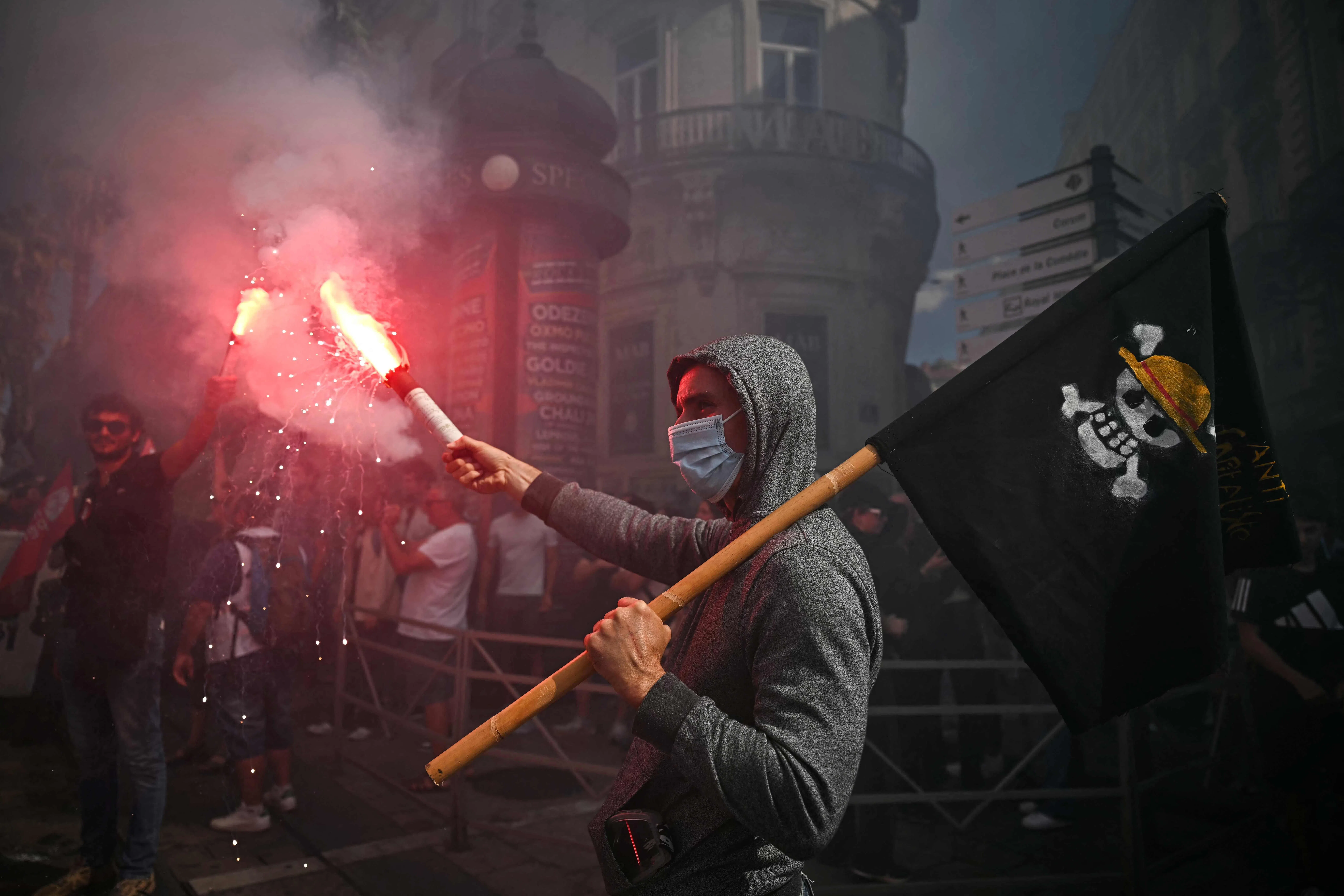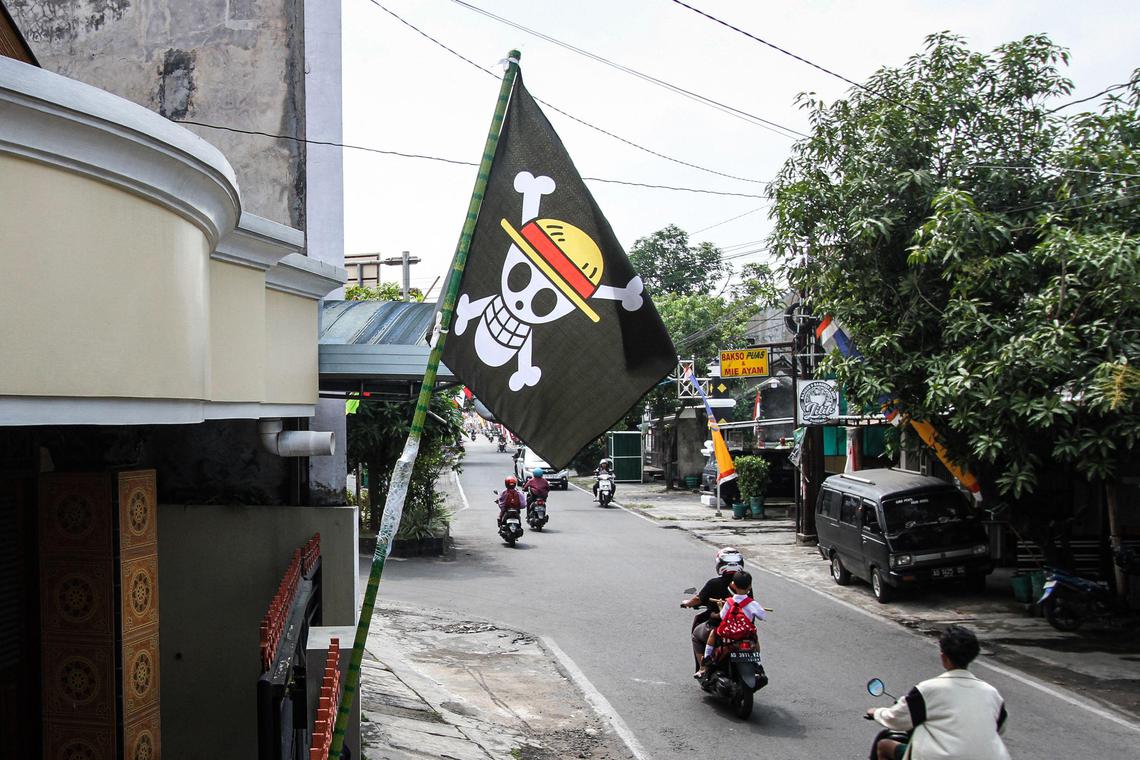News analysis
From Indonesia to Nepal, anime pirate flag has become symbol of Asian Gen Z’s discontent
Sign up now: Get insights on Asia's fast-moving developments

The cartoonish skull on a black banner has increasingly become a protest icon in parts of Asia.
PHOTO: REUTERS
Follow topic:
- The One Piece pirate flag, first used in Indonesian protests, is spreading across Asia and beyond as a symbol of youth resistance against injustice and authoritarianism.
- Inspired by Indonesia, protesters in Nepal, the Philippines, and France have adopted the flag, representing freedom, defiance, and a growing movement against corruption.
- Experts note social media amplifies the flag's spread, fostering international solidarity and reflecting a deeper shift towards social justice and democratic ideals.
AI generated
SINGAPORE – When a pirate flag was unfurled by protesters in Jakarta in July, most of Indonesia’s authorities did not know what to make of it. But many young people there instantly recognised what the toothy skull wearing a straw hat stands for – defiance and freedom.
The cartoonish skull on a black banner, once confined to Japanese anime fandom, has increasingly become a protest icon in parts of Asia.
First used in Indonesia
In Indonesia, the flag was first seen waved by truckers opposing overloaded-vehicle rules and later at student and community protests. Its visibility surged after Aug 28, when 21-year-old motorcycle taxi rider Affan Kurniawan was crushed by a police tactical vehicle during clashes in Jakarta, an incident that fuelled some of the worst unrest in decades.
Officials in the country of 280 million have condemned its display alongside the national flag, called Sang Saka Merah Putih, with police seizing banners in several provinces.

An image shared widely on social media shows a pirate flag from the One Piece anime series hoisted under the national flag of Indonesia.
By early September, the symbol had crossed borders. In Nepal, protesters adopted it during anti-corruption demonstrations that have escalated into deadly clashes since Sept 8, leaving at least 19 people dead and forcing Prime Minister K.P. Sharma Oli to resign.
Images from Kathmandu showed demonstrators identifying as “Gen Z” waving the flag as they railed against censorship, graft and authoritarian rule. Some flags bore slogans such as “The Time is Now” and “#WakeUpNepal”.
The pirate flag is from the hit Japanese anime series One Piece.
The series centres on the Straw Hat Pirates as they seek the ultimate treasure and encounter rivals and the authoritarian World Government. The flag is flown by this crew.
In the Philippines, the flag was spotted during an anti-corruption run at the University of the Philippines Diliman in Quezon City that drew more than 1,000 participants. Photos of the event were later shared on the One Piece forum on Reddit, which has more than 1.6 million subscribers.

In the Philippines, the flag was spotted during an anti-corruption run at the University of the Philippines Diliman in Quezon City.
PHOTO: SCREENGRAB FROM REDDIT
The flag’s use has extended beyond Asia. In France, at protests that began on Sept 10

A protester waving a pirate flag during a demonstration in Montpellier, France, on Sept 10.
PHOTO: AFP
The comic’s global popularity might come as a surprise to some, but the One Piece series has remained the best-selling manga series since it was first published in 1997, selling more than 500 million copies worldwide. It was awarded a Guinness World Record in 2022 for that achievement.
On Netflix, its anime adaptation was first aired in 1999 and now has more than 1,100 episodes. Together with the live-action series that premiered in 2023, it is the third most-streamed franchise on the platform, with more than 174 million views between 2023 and 2025.
For young people like Nepali Rohan Rai, 19, the flag represents freedom, loyalty and defiance against injustice. It was adopted after they saw how Indonesian demonstrators had used it in their own protests.
“We were inspired by them. We must give credit where credit is due, and the youth here were inspired by them,” Mr Rai told The Straits Times in an e-mail interview.
On Instagram, a Nepali user called @sunshine.aroma5656 commented that there is “nothing more powerful” than seeing the One Piece flag raised as a “symbol of protest against corruption”.
She added that while some might dismiss the use of an anime emblem, the flag embodies the characters’ spirit of rebellion and pursuit of freedom.
“They rebel, fight for freedom, and now it’s our turn. The corrupted world in One Piece mirrors our country today and it’s time to rise and rebel,” she said.
Dr Natalie Pang, head of the communications and new media department at the National University of Singapore, noted that while pirate flags were historically used to intimidate and instil fear, One Piece has reimagined them as symbols of freedom, friendship and the pursuit of dreams.
She explained that symbols like the Jolly Roger pirate flag resonate across cultures because they distil such complex ideas into visuals that are both simple and striking.
“They can be quite effective for collective expression as well as mobilisation because people can rally around the shared meanings and values that they perceive that the symbol represents,” said Dr Pang.
What is unfolding with the flags can be seen as a “remix of popular and political cultures”, she said, pointing out how entertainment symbols can take on new meanings when used in political participation.
“The symbols are not only shaped by political and social issues, but also shape how people participate in politics, be it protests, deliberation or discussions,” she added.
The flag’s growing adoption shows how closely Indonesia’s protests are being watched, said Mr Edbert Gani Suryahudaya of think-tank Centre for Strategic and International Studies. He added that its use reflects how Japanese culture is deeply rooted among the young and has inspired them to take action.
“Theoretically, international influence in social movements is not new. Almost all large-scale social movements in history have involved some diffusion of ideas across borders,” he said.
His colleague, Mr D. Nicky Fahrizal, noted that the waving of the One Piece flag reflects a broader current of grassroots resistance. He said the movement is being shaped by social networks and digital crowdsourcing, which are enabling citizens to organise across borders.

A pirate flag installed at a house in Solo, Indonesia.
PHOTO: AFP
“The issues are clear: Experiences of social injustice, corruption and state violence have been the main driving forces,” added Mr Nicky.
“On that basis, strategies of resistance do not always appear in formal arenas. At times, they emerge instead through the channels of popular culture.”
He said the spread of the flag, accelerated by social media, signals how the fight of social justice has entered the mainstream, with more citizens willing to confront what they see as declining standards of economic, social, political and legal governance.
“The flag could be seen as a sign of growing international solidarity among young people determined to fight for democracy in their own countries,” Mr Edbert added.
“It is possible that this moment will not stop here and may even expand to influence other parts of the world.”


